[current_post_breadcrumbs]
Lab grown diamonds
Everything you need to know about synthetic diamonds
[current_post_author_name]
[current_post_mdate]
Over the last couple of years, lab grown diamonds have become increasingly popular, as people search for a more eco-friendly, a more wallet-friendly or a more ethical choice.
And lab grown diamonds have got the traditional jewelry industry shook.
They’re shook.
The ability to grow diamonds and sell them for significantly lower prices has the potential to completely change the industry.
But there’s a lot of information and misinformation out there, from both traditional jewelers and companies that produce lab grown diamonds.

Ringspo is reader supported
Ringspo is reader-supported, which means we may receive a commission if you click a link to a retailer & subsequently make a purchase.
We feature links to several retailers to help readers find the one that is the best fit for them. Find out more about how Ringspo works here.
Note: While this website is primarily about natural diamonds, when conducting the research for this we went into it with a completely open mind.
As such, we have tried to be as balanced and fair to both sides of the debate.
We want to inform our readers and help them make an informed choice, free from the marketing spin from vendors on both sides.
First up – just what are lab grown diamonds?

OK, we’re going to get the elephant out of the room. Lab grown diamonds are identical to diamonds that were formed by mother nature.
This is the chemical structure of a diamond that was formed 3 billion years ago:

And this is the chemical structure of a diamond that was formed 3 weeks ago:

If you’re squinting at those, let me help: they’re exactly the same.
Stephen Morisseau, a spokesman for the Gemological Institute of America (one of the most respected diamond grading organisations) said:
[Lab-created diamonds] are not fakes. They’re not cubic zirconias. They have all the same physical and chemical properties of a mined diamond.
So lab diamonds aren’t ‘fake’ diamonds in any way – they’re just as hard and they sparkle just as brilliantly..
Soooooo, what are ‘synthetic diamonds’?
Synthetic diamonds is another name for lab grown diamonds. Technically the name is correct as lab grown diamonds are grown through a ‘synthesis’ process and when lab-grown diamonds are discussed in scientific journals, ‘synthetic’ is always used, even by people that produce them.
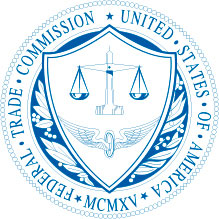
To clear up any confusion about whether ‘synthetic diamonds’ are real or fake, the FTC recently (April 2019) changed its recommendations on how lab grown diamonds should be described, recommending the terms ‘lab grown’ or ‘lab made’, and leaving out ‘synthetic’.
Other names for lab grown diamonds that you may see are:
- LG diamonds
- LGD (this is becoming increasingly popular)
- Lab created diamonds
- Man made diamonds
- Cultured diamonds
- Engineered diamonds
- Above-ground diamonds
- Factory-produced diamonds (this is a term often used by traditional jewellers who want to reduce the perceived value of lab grown diamonds)
The terms we’re going to use
On this page, we’re going to use the term ‘lab grown’ throughout, to keep things clear and consistent.
On the other side, we’re going to use the term ‘natural diamonds’ to describe diamonds that were created by mother nature.
Other terms that are commonly used for natural diamonds, depending on who is speaking, are:
- Earth-created diamonds
- ‘Real diamonds’ – often used by traditional diamond companies who want to position their products as more authentic than lab grown diamonds
- Mined diamonds’ – often used by lab grown diamond companies who want to remind customers of the environmental impact of natural diamonds
As you can see, there’s marketing spin on both sides – from traditional jewelers and from lab grown diamond companies.
How are lab grown diamonds made?

The process for creating lab grown diamonds basically involves recreating the circumstances that natural diamonds are formed in. But instead of taking millions of years, lab grown diamonds take just a few days to create.
This is going to be a teeny tiny chemistry lesson, but bear with me here
Understanding how diamonds, both natural and lab grown, are made is important to understanding how similar they are.
How natural diamonds are made
Natural diamonds were formed deep within the Earth between 1 billion to 3 billion years ago when carbon dioxide was exposed to huge levels of heat (around 2,200 degrees Fahrenheit, which is about the same as the inside of a McDonald’s apple pie) and put under extreme pressure.
The diamonds are then transported from deep within the Earth’s core to the surface by volcanic explosions.

So, carbon is heated and compressed and a diamond is formed.
Got it.
How lab grown diamonds are made
- High Pressure-High Temperature (HPHT), or
- Chemical Vapor Deposition (CVD)
We’re going to take a quick look at each of these now
HPHT lab grown diamonds
HPHT lab grown diamonds start with a ‘seed’ of ‘real’ diamond, which looks like this:

These seeds are then placed into a ‘press’, which is basically a giant pressure cooker:

The press recreates the crushing force of the earth by applying extreme temperatures (around 1,500°c) and pressure.
That’s a big and pretty meaningless number, but it’s basically as much pressure as you would feel if you turned the Eiffel tower upside down and balanced it on your finger.

The heat and pressure melts the carbon and starts to form a diamond around the starter seed. It is then carefully cooled to form a diamond crystal, which are then cut and polished, just like a natural diamond:
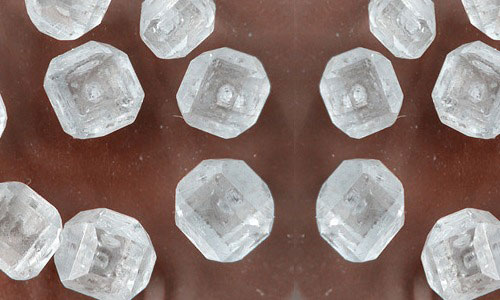
So, carbon is heated and compressed and a diamond is formed, just like with a natural diamond.
CVD lab grown diamonds
The second technique is called Carbon Vapor Deposit or CVD.
It again starts with a seed of diamond,
A vacuum chamber is filled with a gas that contains carbon, which are then shot with a high-powered microwave beam (pew pew!), which splits the methane into different gases.

The carbon in the methane is the heaviest, so it falls onto the diamond seed where it grows into a diamond.
It is basically 3D printing a diamond by adding layers of carbon onto a diamond seed.
Some lab diamonds grown through CVD are then subject to HPHT to ‘compress’ the diamond to improve their color.
CVD usually produces higher quality diamonds than HPHT, but both processes are used to create diamonds used in jewelry.
It takes 7-10 days to grow a 1 carat lab diamond, and about a month to grow a 3 carat diamond.
Still here?
Great!
Are lab grown diamonds new?
Lab grown diamonds being used in jewelry are pretty new, yes.
The technology has only advanced to a point where the manufacturers could create diamonds large enough and clear enough for use in jewelry in the last 6 or 7 years.
But lab grown diamonds have been produced since the ‘50s for use in industrial applications, like drills and saws.

OK, now you have a solid understanding of what lab grown diamonds are, let’s look at some info you need to know when deciding whether they are right for you.
Can you tell the difference between lab-grown and natural diamonds?
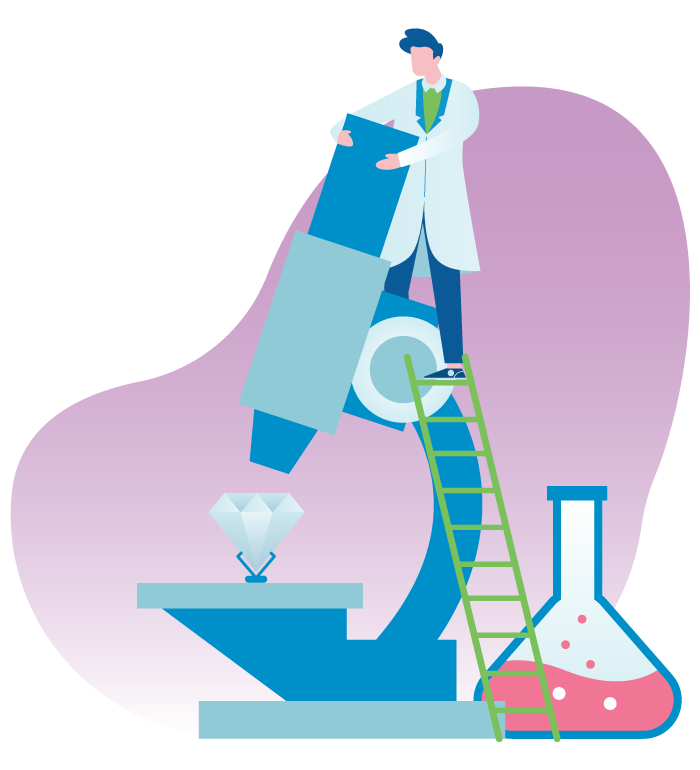
They’re formed the formed using the same processes as natural diamonds, have the same chemical structure and the same physical properties, so is there any way to tell the difference?
A jeweler using traditional diamond examination tools won’t be able to tell the difference between a lab grown and a natural diamond.
When looking through a jewelers loupe, the diamond will look exactly the same:

Many jewelers have ‘diamond tester’ tools, which are designed to test the difference between diamonds and imitation diamonds e.g cubic zirconia and moissanite.

These work by heating the precious stone and then seeing how they react to the heat. As lab grown diamonds are chemically identical to natural diamonds, they react to heat in the same way, so these testing tools will identify lab grown diamonds as bona fide diamonds.
But the labs that grade diamonds for quality can tell the difference between natural and mined diamonds using.. At least at the moment!
The gem labs use ‘lightboxes’ which shines different wavelengths of lights at the diamonds. These lightboxes can pick up traces of elements that appear in lab grown diamonds and not in natural diamonds.
Are lab grown diamonds 100% pure?
You might expect that diamonds that are grown would be 100% perfect, with no inclusions or imperfections. Like the coat of a baby arctic fox.
But because lab grown diamonds are created by mimicking the conditions that natural diamonds form in, they have the same variations of color and clarity that exist in natural diamonds.
This means that the 4Cs still need to be considered when choosing a lab grown diamond.
Are lab grown more environmentally friendly?

One of the major selling points of lab grown diamonds is their eco-friendly credentials.
On the surface, this sounds like it should be a no-brainer that lab grown diamonds are more environmentally friendly than mined diamonds. After all, mined diamonds are dug out of huge holes in the ground, while lab created diamonds are produced in a, well, lab.
However, it’s actually surprisingly difficult to quantify the extent to which this is true and there’s a lot of marketing spin from both sides.
When conducting research into the relative benefits of lab grown vs. natural, it was surprisingly difficult to find solid information about the relative environmental impact of lab grown diamonds vs. natural.
If you read many lab grown diamond sellers websites about the benefits of lab grown diamonds compared to natural diamonds, much of it is based on outdated information, or with facts carefully cherry-picked.
They focus more on the harm that mined diamonds cause, while giving few details about their own production process, other than using hard-to-define terms like ‘environmentally kind’.
In fact, eight of the largest lab grown diamond companies were reprimanded by the FTC about using terms like ‘sustainable’ without providing sufficient evidence to back up their own claims.
Why establishing the eco-friendly credentials of lab created diamonds is complicated
The issue is complicated because of the way lab grown diamonds are currently created.
Throughout this article, I’m using the term ‘lab grown diamonds’ as this is currently the most commonly used term to refer to them.
Using the word ‘lab’ conjures up ideas of scientist in white coats conducting experiments. It evokes a perception of innovation and technological advancement.
But while the research and development may place in a laboratory setting, the manufacturing practices are much more like a factory, with rows of heavy machinery lined up:
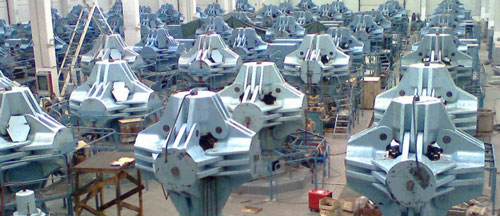
The image above shows HPHT machines, and to grow a 2.5-carat rough lab-created diamond (which will give a 1 carat cut and polished diamond that could be used in an engagement ring) typically takes 3-4 weeks.
This means each one of these machines needs to be consuming enough energy to simulate the heat of a volcanic explosion and as much pressure as the Eiffel tower, upside down on your finger for three 3-4 straight weeks. For a larger diamond? Considerably longer.
Comparing the ecological impact of lab grown and natural diamonds
The three factors that we will use to assess the relative ecological impact of lab grown diamonds vs. natural are:
- Energy usage
- Energy source and carbon neutrality
- Land conservation
However, direct comparison is surprisingly difficult due to the difference in transparency between natural diamond companies and lab grown companies, and the variation in the types of mining that are used to produce diamonds.
Natural diamond companies are large organisations with sophisticated social responsibility programs which are externally audited.
Lab grown companies are much smaller at present, which means that they aren’t subject to the same focus and aren’t asked to verify any of their claims.
Despite this, we’ll look at the information available. If you would like more information about any of these topics then further reading can be found in:
- Sustainable Sparkle: The Environmental Impacts Of Mined vs. Lab-grown Diamonds
- Just How Eco-Friendly Are Lab-Created Diamonds?
Both articles give an excellent summary of the arguments. However, it should be noted that they are both traditional jewelry industry publication, so may be more likely to favour ‘traditional’ mined diamonds.
Lab grown vs. natural diamonds: energy usage
Jason Payne, founder of lab grown diamond retailer ADA claims:
“the “most efficient” diamond growers use 250 kWh per carat, which is the same amount of electricity the average U.S. household uses in 8.7 days or the electricity to fully charge a Tesla two-and-one-half times. But most use around 3 times this – about 750 kWh to grow 1 carat of diamond.”
How does this compare to mined diamonds?
Saleem Ali, an environment professor at the University of Delaware, found in a 2013 paper that De Beers’ operations use 80.3 kWh per carat and Canadian Diavik mines consumer 66 kWh per carat.
However, this doesn’t necessarily give the whole picture as it doesn’t include the exploration to find diamond mines and transportation. Diamond mines are often in extremely inaccessible places, and the transport energy requirements are likely to be significant.
To confuse things slightly, in this paper Ali also gives a figure of 20kWh per carat for lab grown diamonds for a diamond producer named ‘Gemesis’, which is now no longer in business.
Estimates of the energy needed to grow 1 carat of diamonds therefore vary from 20 kWh to 250 kwH to 750kWh.

This lack of real data is what makes clear conclusions about the relative benefits of lab grown diamonds so difficult to verify.
Lab grown vs. natural diamonds: Energy sources and carbon neutrality
Lab grown diamonds should have a home-run here. If they can power their production facilities with renewable energy, then it would hugely reduce their impact on the environment.
However, currently most HPHT diamonds are produced in China, which sources 55% of its power from coal and 20 percent from hydro. India is the second largest producer, where 75% of grid power comes from coal and 10 percent from hydro.
However, individual retailers may do better than this. Diamond Foundry produces its diamonds in San Francisco and has been certified carbon-neutral after buying ‘solar credits’ to offset their diamond production and transportation energy requirements.
Some natural diamond companies are also working towards making their operations carbon neutral – DeBeers is currently conducting research in Canada which will allow them to counter the affect of their mining through their own operations rather than having to buy credits.
Lab grown vs. natural diamonds: Land conservation
There’s no way around this one. Natural diamonds require large holes to be dug in the ground and lab grown diamonds do not:

One frequently quoted statistic is it takes 250 tons of earth to produce 1 carat of polished diamond.
To counter this, as part of their corporate social responsibility De Beers protects six hectares of land for every one hectare that is disturbed for mining, but it’s inarguable that ecosystems are disturbed.
Research into the extent of this by independent agency Trucost calculated that the members of the Diamond Producer Association collective negative impact on land usage, water depletion, pollution, and waste is compensated by the positive benefits associated with their biodiversity programs. The key findings are worth reviewing, but it should also be noted that the research was paid for by an organisation made up of the largest diamond mining organisations in world.
Some diamond industry insiders point to other products that are are commonly purchased with much less consideration over the potential environmental impact e.g. the mining practices that produce the rare earth minerals for use in smartphones, for a product that is likely to be used for 2 years and then disposed of, while a diamond is (hopefully!) for significantly longer.
However, this deflection doesn’t sit well with me and when it comes to land conservation, lab grown diamonds definitely wins. It is surely better to leave land alone, rather than disturb it and then replenish other land.
The future of sustainability and lab grown diamonds
Sustainability and lab grown diamonds is obviously extremely interesting to consumers, and lab grown diamond manufacturers are keen to be able to demonstrate their eco-friendly credentials.
The newly formed Lab-Grown Diamond Council has enlisted SCS Global Services – an environmental certification company – to create a standard that will allow qualifying diamond growers to call their products “sustainably grown diamonds.”
This will have have three pillars:
- environment impact
- social responsibility
- community benefit
However, this unfortunately isn’t live yet.
Reducing your ecological impact when choosing your ring
If you are looking for a truly low-impact engagement ring and would still like a diamond, then really the best choice is to buy a second hand ring, where the environmental impact is long in the past.
Websites like idonowidon’t sell authenticated second hand diamonds, taking the risk out of buying second hand, while Erstwhile Jewelry has an incredible selection of vintage rings.
But if this sounds like I am trying to put you off buying a ring that features a new diamond, I’m not. Diamonds undoubtedly do have an ecological impact, but the industry is actively working to reduce this with major players like De Beers pledging to be carbon neutral by 2022 and setting aside significantly more land for preservation than it disturbs.
Are lab grown more ethical?

Mined diamonds have had a public perception issue since the film ‘Blood Diamond’, and many lab grown retailers still prey on these concerns when positioning their diamonds as a more ethical choice.
But, like many things, the situation is more nuanced than that.
Conflict Diamonds
A conflict or ‘blood’ diamond is a diamond that comes from areas—particularly in central and western Africa— that are illegally traded to fund war and violence.
In the early 90s, civil war broke out in Sierra Leone, and thousands died in a war that spanned over a decade. Sadly, this war was partly financed by the illegal trade of diamonds, the proceeds of which financed the purchase of weapons which allowed the war to continue.
Conflict diamonds have also financed violence in Angola, The Ivory Coast, The Democratic Republic of the Congo, Liberia, Republic of the Congo, and Zimbabwe.
The Kimberley Process
Governments, charities, and the diamond industry united after the civil war in Sierra Leone to create the Kimberley Process in an attempt to prevent the diamond trade from directly or indirectly financing or supporting a conflict.
Launched in 2003, the Kimberley Process is made up of 80 participating countries representing most of the nations involved in the diamond trade and it has successfully reduced the conflict trade to less than 1% in the global diamond industry.
However, it is not perfect, and it does have its loopholes as conflict diamonds continue to enter the trade even from participating countries due to the lack of regular, independent monitoring.
GemFair
The issue with the Kimberley process is often the smaller, ‘artisanal’ mines, rather than the large-scale mines owned by multi-national corporations. The workers in these artisanal mines often don’t have the connections they need to get the diamonds they produce into the legitimate supply chain.
GemFair is a fairly new scheme scheme which aims to connect artisanal and small-scale miners to the global market through digital technology and assurance of ethical working standards.

Gem Fair is currently being trialled in Sierra Leone in partnership with the Government and hopes to benefit the 1.5 million people in developing countries that work as artisanal diamond miners.
The economic benefits of Diamonds
As well as the 1.5 million artisanal diamond miners mentioned above, diamonds are also an industry that has helped lift whole countries out of poverty.
When Botswana achieved independence in 1966, it was one of the poorest countries in the world. Its per capita income was $70 a year, there were only 12km of paved roads the economy based around cattle and agriculture and life expectancy was 37 years.
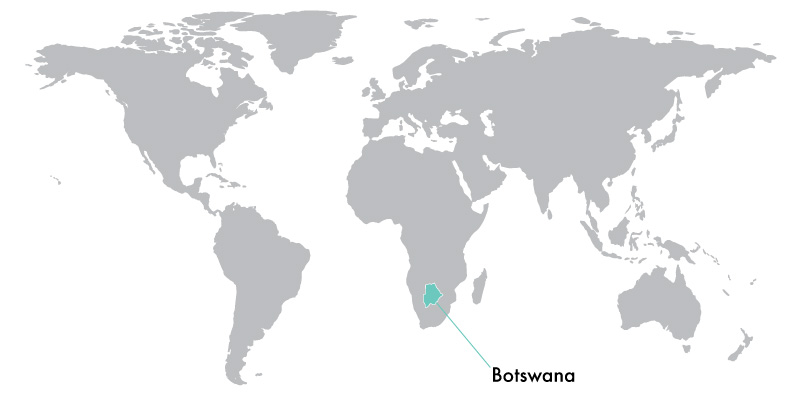
Today, Botswana is among the most prosperous countries in Africa, with a real middle class and a per capita income of over $7,500 a year. According to GDP PPP (purchasing power parity), Botswana now has a per capita of about $18,825, making Botswana an upper- middle-income country comparable to Chile or Mexico. By 2007 Botswana had 7,000km of paved roads. Its success is also evident in other measures of human development.
At independence, life expectancy at birth was 37 years. By 1990 it was 60, 10 years above the African average. Under-five mortality had fallen to about 45 per 1,000 live births in 1990, compared with 180 for Africa as a whole.
According to the World Bank, the cause of this huge change in the fortunes of Botswana was diamonds. In 1967, the year after independence, a huge diamond mine was discovered in a remote area called Orapa, about 250 miles from the capital city of Gaborone.
De Beers’s entered into a 50-50 joint venture with the government to ensure that the revenue from the diamonds benefited the country and it has continued to invest in the country.

Diamonds now represent 88% of the total exports of Botswana and around 20% of GDP. This makes the diamond industry – mining, cutting and polishing, and sales – the most important economic activity for the country.
Diamond Development initiative
The Diamond Development Initiative (DDI) is a non-profit organization that works to reduce poverty and promote sustainable development through education, policy, dialogue and projects working directly with artisanal diamond miners and their communities.
Director of DDI Dorothée Gizenga speaks for these artisanal miners and their communities:
“Artisanal diamond mining is the livelihood of millions of people. They have an average of 10 dependents, including children. That is a significant amount of people depending on this industry. For them, that is the only livelihood that is available.”
Are lab grown diamonds more ethical than mined?
This depends on how you look at it.
Lab grown diamonds are guaranteed to be conflict-free, which is undoubtedly a good thing. Conflict diamonds have prolonged wars and brought significant suffering to those affected.
The diamond industry has worked to end the trade of conflict diamonds through the Kimberley Process, although it isn’t perfect. In the future, it’s hoped that the use of blockchain will ensure that no conflict diamonds enter the supply chain.
When properly managed, diamond mining is a key source of employment for millions of people in areas that may otherwise have few opportunities.
Saleem Ali, the environmental professor at the University of Delaware who has studied the environmental and societal effects of diamonds says:
There are few other options for livelihood in far-north Canada or Botswana. Synthetics are not going to generate a lot of jobs. When the diamond mining industry is well-governed, it has the potential to benefit people greatly in very poor areas.
Lab grown diamond certification

Diamond certification is absolutely essential when buying a diamond. It ensures that you are getting what you pay for and allows you to compare different stones to make sure that you can get the balance of qualities that are right for you.
GIA and lab grown diamonds
GIA is the lab that I most frequently recommend for natural diamonds. They do grade lab grown diamonds and they make it very clear on the grading report (or certificate) that the diamond is lab grown.

Note, GIA used to use the term ‘synthetic diamond’, and for older grading reports, this may still be the term shown.
However, for lab grown diamonds, GIA hasn’t quite come to the table and don’t currently use the same grading scale for laboratory diamonds for color and clarity as they do for natural diamonds.
For example, the GIA color grading scale for natural diamonds is:

There are descriptive groups ‘colorless’, ‘near colorless’ etc, and each of these are broken down into smaller grades which are indicated using letters. A diamond graded G and a diamond graded J are both in the ‘near colorless’ grade, but with J will look noticeably warmer and more yellow.
With lab- grown diamonds, GIA don’t break their categories into the more granular letter grades. Instead, they just use the overall descriptive color grade e.g.‘Near colorless’:

There are a few technical reasons for this, but ultimately it means that most lab grown diamond sellers don’t choose to use GIA to grade their diamonds as it makes them difficult to compare to natural diamonds.
IGI and lab grown diamonds
The grading report (or certificate) that is most commonly found with lab grown diamonds is IGI:

Unlike GIA, IGI grades lab diamonds on the same scale as natural diamonds with the more granular grades for color and clarity:

This makes it significantly easier to compare lab grown individual diamonds to make sure that you are getting the quality you are looking for.
Are lab grown diamonds cheaper?

Lab grown diamonds are significantly less expensive than natural diamonds.
And prices of lab grown diamonds have been consistently falling over the last two years as the supply increases.
There is no hard and fast rule of how much less expensive lab grown diamonds are than natural diamonds. The exact difference will depend on the size and quality of the diamond, and the retailer that you are looking at.
However, looking at a couple of comparisons, we can see that lab grown diamonds are usually priced at around 40% – 50% of the price of a natural stone.
Lab-grown vs. natural price comparison 1: Round Brilliant
The following are specs that I would be happy to recommend for an engagement ring:
- 1 carat
- E color
- VS2 clarity
- Ideal / Excellent cut
Comparing the price of a lab grown and a natural diamond with these specs at the same retailer, there’s a big difference in price:
Lab-grown diamond:

Natural diamond:

At $2,260, the lab grown diamond is $3,140 less expensive than the natural diamond.
It is priced at 42% of the price of the natural stone.
1 carat is a popular weight for diamonds, so there is a lot of supply at this size.
Lab-grown vs. natural price comparison 2: Princess cut
If we look at a larger princess cut, the difference is still significant, but not quite so marked. Comparison specs:
- 3 carat
- G color
- VS1 clarity
- Ideal cut
Lab grown diamond:

Natural diamond:

At $19,000, the lab grown diamond is $20,340 less than the natural diamond, so it costs 48% of the price.
Lab grown diamond prices over time
When lab grown diamonds very first became available for use in jewelry, they were frequently priced higher than natural diamonds.
The technology to produce them was new and people seemed willing to pay a premium for the perceived environmental benefits.
However, over the last three years, lab grown diamond production and supply has increase, which has resulted in prices decreasing.
Diamond industry analyst Paul Zimnisky tracked 1 carat diamond prices from the beginning of 2016 to the third quarter of 2018:
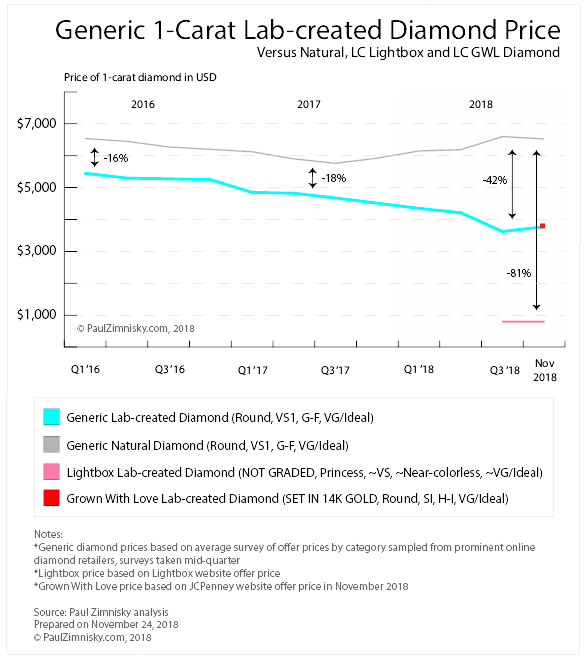
At the beginning of 2016, a 1 carat lab grown diamond was on average 16% less expensive than a natural diamond.
By mid 2017, this difference had increased to 18%.
But in the third quarter of 2018, lab grown diamonds were 42% less expensive than natural.
And as we saw in the examples above, they are frequently less than 50% of the price.
Why lab grown prices are changing
The reason that lab grown diamond prices are changing all the time is because technology for creating lab grown diamonds is becoming more widespread and less expensive. And as the tech become more widespread, supply increases and the price reduces.
One big change in the lab grown market that is reflected on the graph above is the entrance of one of the largest diamond producers – De Beers.
If you look at the graph above, there is a horizontal pink line from Q3 ’18 onwards at just under $1,000, which reflects the price of a 1 carat princess cut ‘Lightbox lab-created diamond’.
This was a huge change in the marketing which could cause the price of lab grown diamonds to tumble further.
‘Lightbox’ lab grown diamonds
First, a quick history lesson. DeBeers is a huge diamond conglomerate who controlled the diamond trade for much of the 20th Century and are responsible for the ‘A diamond is forever’ ad campaign which single-handedly cemented the idea of proposing with a diamond.

While not the monopoly it once was, DeBeers is still one of the biggest diamond mining companies in the world. And they have also been a market leader in creating synthetic diamonds for industrial purposes since the ‘50s.
For a long time, DeBeers didn’t offer lab grown diamonds and most people thought they never would as it would impact their very successful business selling natural diamonds.
However, in 2018, De Beers shocked the industry by launching a lab grown diamond consumer brand called ‘Lightbox’ with prices way, way lower than other lab grown producers:
Lightbox will transform the lab-grown diamond sector by offering consumers a lab-grown product they have told us they want but aren’t getting: affordable fashion jewelry that may not be forever, but is perfect for right now.
One big difference between the lab created diamonds produced by De Beers and those sold by other retailers is that lightbox doesn’t provide any certificates, so consumers aren’t able to judge the quality of the stone by the 4Cs.
The reason De Beers give for this is that as the diamonds were produced by man made methods, they aren’t individual, in the same way that natural diamonds are:
“Lab grown are not special they’re not unique. You can make exactly the same one again and again.”
This doesn’t quite hold up to examination as lab grown diamonds do still have variations in colors and clarity, and the amount they sparkle will be determined by how well they are cut.
The non-traditional styles and the lack of certification make Lightbox a less attractive choice for a significant purchase like an engagement ring, but the value that they offer is undoubtedly excellent, especially for items such as lab grown diamonds earrings.
The difference between Lightroom and other lab grown jewellers is that Lightroom is positioned as ‘fashion jewelry’, rather than ‘fine jewelry’ ie. jewelry that may be used in an engagement ring and possibly be passed down to the next generation.
Bruce Cleaver, chief executive officer of De Beers:
What does the future hold for lab grown diamonds?

We’ve helped many people find their perfect lab grown diamond and will happily continue to do so.
We’re seeing an increasing number of people choosing them over natural stones and looked at logically, they make sense. They deliver an almost-identical product at a much lower cost.
But diamonds and jewelry aren’t a logical purchase, they are a hugely emotional one. As a result, the future of lab created diamonds is somewhat uncertain.
On this page, we’ve tried to give you a realistic overview of the current state of lab grown diamonds, as free from the marketing hype on the side from those who are selling lab grown diamonds and the negative grizzling from the traditional mined diamond industry too.
At the moment, a lot of the ‘green’ arguments for lab grown diamonds are actually quite hard to back up with data, although we don’t imagine that this will always be the case. As lab grown diamonds manufacturers mature, they will be able to demonstrate that their stones have a smaller environmental footprint than natural through the use of renewable energy supply.
What isn’t certain though is how ‘valuable’ lab grown diamonds will be viewed as in the future.
Other gemstones and man-made stones
Other precious gems had man-made versions of them available for longer than diamonds, and it’s interesting to see how they have panned out.
Synthetic rubies are commonly available and haven’t diminished the price of natural rubies at all.
A 2 carat natural ruby can cost around $10,000:

A similarly-sized synthetic ruby costs 1/1000th of that:

The reason for this huge difference in price is rarity.
Lab created rubies are easy to produce and common, while high quality natural rubies are very rare.
Should you choose a lab grown diamond?
Whether you choose a lab grown diamond for your ring is completely your choice.
It is a great way to get a diamond that delivers more carat weight for a lower price than a natural stone.
However, there is still significant uncertainty about the ‘value’ of lab created diamonds, and what may cost $5,000 today may be available for significantly less money in the future.
Despite this though, it would still be just as good a diamond as it was when you purchased it, so if you are happy with this potential uncertainty then they make a great choice.










It is worth reading. If you are looking for the best company then provide good quality of poly crystalline cvd diamond anvil cell then imat is the best option as we provide various cvd diamonds products at an affordable cost.